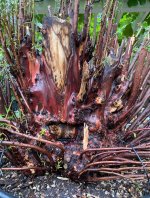Rivka
Shohin
A couple of weeks ago, I pulled the heaviest, thickest “urbandori” I have ever (and who knows, may ever) get as future bonsai material. Someone needed a Taxus removed to install a fence, so while the timing was not the best, it was non-negotiable. While the price was “free,” in reality it cost me a 3-hour round-trip drive, 6 hours of hard labor, and 1 new chainsaw blade.


It was much larger a trunk than I could have hoped for. Clearly, it was way older than it looked at first glance, and had been cut down to just a few feet and regrown, maybe a few times.
I barely got into a container; it currently takes the full depth of this container with a 10” diameter root that I didn’t dare cut back further in this initial potting up. It will need a massive reduction, but in the future.


Wish I had a more suitable container for it, was honestly unprepared for how deep the massive underground portion was. Keep wondering with such an aggressive transplant if it should be placed in something even bigger or even the ground while it recovers over the next few years? Its definitely going on a heat mat and in the greenhouse for this winter.


It was much larger a trunk than I could have hoped for. Clearly, it was way older than it looked at first glance, and had been cut down to just a few feet and regrown, maybe a few times.

I barely got into a container; it currently takes the full depth of this container with a 10” diameter root that I didn’t dare cut back further in this initial potting up. It will need a massive reduction, but in the future.


Wish I had a more suitable container for it, was honestly unprepared for how deep the massive underground portion was. Keep wondering with such an aggressive transplant if it should be placed in something even bigger or even the ground while it recovers over the next few years? Its definitely going on a heat mat and in the greenhouse for this winter.
